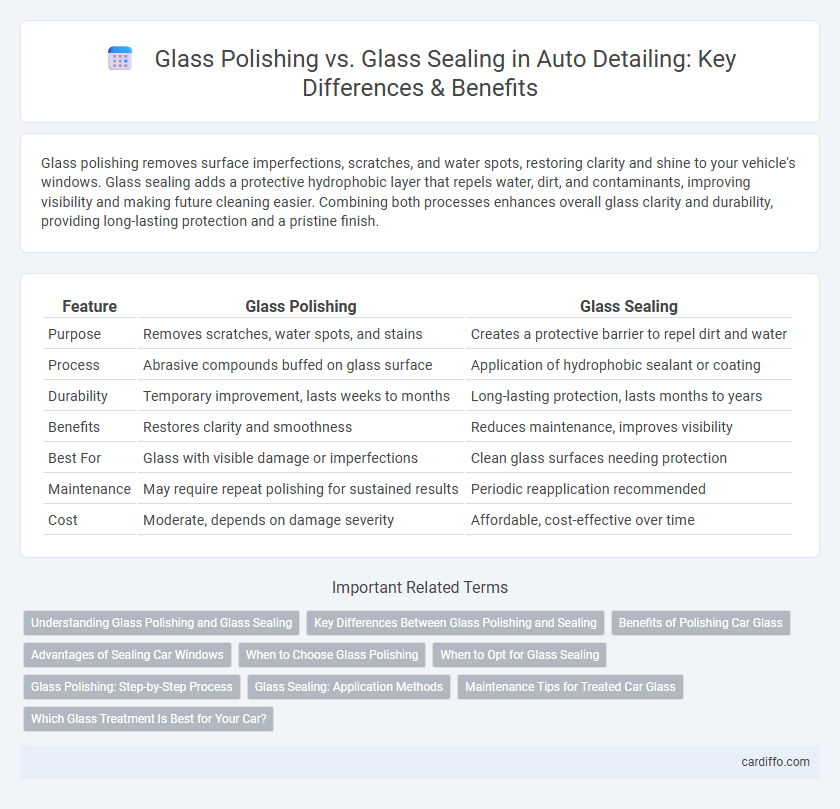Glass polishing removes surface imperfections, scratches, and water spots, restoring clarity and shine to your vehicle's windows. Glass sealing adds a protective hydrophobic layer that repels water, dirt, and contaminants, improving visibility and making future cleaning easier. Combining both processes enhances overall glass clarity and durability, providing long-lasting protection and a pristine finish.
Table of Comparison
| Feature | Glass Polishing | Glass Sealing |
|---|---|---|
| Purpose | Removes scratches, water spots, and stains | Creates a protective barrier to repel dirt and water |
| Process | Abrasive compounds buffed on glass surface | Application of hydrophobic sealant or coating |
| Durability | Temporary improvement, lasts weeks to months | Long-lasting protection, lasts months to years |
| Benefits | Restores clarity and smoothness | Reduces maintenance, improves visibility |
| Best For | Glass with visible damage or imperfections | Clean glass surfaces needing protection |
| Maintenance | May require repeat polishing for sustained results | Periodic reapplication recommended |
| Cost | Moderate, depends on damage severity | Affordable, cost-effective over time |
Understanding Glass Polishing and Glass Sealing
Glass polishing involves the removal of surface imperfections, scratches, and oxidation to restore clarity and smoothness to automotive glass, enhancing visibility and aesthetic appeal. Glass sealing creates a protective hydrophobic layer that repels water, dirt, and contaminants, preventing damage and making cleaning easier while maintaining the polished surface. Both processes are essential in maintaining glass longevity and performance, with polishing addressing surface defects and sealing providing ongoing protection.
Key Differences Between Glass Polishing and Sealing
Glass polishing removes surface imperfections such as scratches, water spots, and oxidation by physically abrading the outer layer of the glass to restore clarity and smoothness. Glass sealing applies a protective coating that repels water, dirt, and contaminants, enhancing durability and reducing the frequency of cleaning. The key difference lies in polishing being a restorative process to improve glass appearance, while sealing is preventive maintenance providing long-lasting protection.
Benefits of Polishing Car Glass
Polishing car glass removes surface scratches, water spots, and oxidation, restoring clarity and improving visibility while driving. This process enhances safety by reducing glare from headlights and streetlights, especially during nighttime or adverse weather conditions. Polished glass also facilitates easier cleaning and prolongs the lifespan of the windshield, preventing premature replacement costs.
Advantages of Sealing Car Windows
Sealing car windows creates a protective barrier that repels water, reduces dirt buildup, and prevents staining, significantly improving visibility during adverse weather conditions. This hydrophobic layer also minimizes the risk of glass degradation from UV exposure, extending the lifespan of the car windows. Compared to glass polishing, which primarily removes surface imperfections, sealing enhances long-term maintenance by preserving the glass's clarity and structural integrity.
When to Choose Glass Polishing
Choose glass polishing when removing surface imperfections such as scratches, etching, or water spots from your vehicle's glass is necessary to restore clarity and smoothness. Polishing is ideal for older or heavily damaged glass that cannot be adequately protected by sealing alone. For maintaining glass integrity and visibility, polishing provides a more effective solution before applying any protective sealants.
When to Opt for Glass Sealing
Glass sealing is the preferred choice when long-term protection against water spots, mineral deposits, and environmental contaminants is required, especially for vehicles exposed to harsh weather conditions. Unlike glass polishing, which primarily removes surface imperfections and minor scratches, glass sealing forms a durable, hydrophobic barrier that significantly enhances water beading and repels dirt. Opt for glass sealing when aiming to maintain clear visibility and reduce the frequency of glass cleaning for an extended period.
Glass Polishing: Step-by-Step Process
Glass polishing involves a detailed step-by-step process starting with thorough cleaning to remove surface contaminants. Next, abrasive compounds and polishing pads are applied systematically to eliminate minor scratches, water spots, and oxidation, restoring clarity and shine. Finally, the glass is buffed using a high-speed polisher to achieve a smooth, crystal-clear finish that enhances visibility and aesthetics.
Glass Sealing: Application Methods
Glass sealing involves applying specialized protectants that create a hydrophobic barrier on the glass surface, enhancing durability and water repellency. Common application methods include spray-on treatments, wipe-on techniques with microfiber cloths, and using foam applicators to ensure even coverage. Proper curing time and surface preparation are essential to maximize the sealing effectiveness and longevity.
Maintenance Tips for Treated Car Glass
Glass polishing removes surface scratches and contaminants, restoring clarity and smoothness to the car glass, while glass sealing applies a protective layer that repels water, dirt, and reduces future damage. To maintain treated car glass, regularly wash with pH-balanced, non-abrasive cleaners and avoid using harsh chemicals or rough cloths that can degrade the sealant or reintroduce scratches. Reapply sealant every 3-6 months to ensure long-lasting protection and optimal visibility during adverse weather conditions.
Which Glass Treatment Is Best for Your Car?
Glass polishing removes surface imperfections such as scratches and water spots by smoothing the glass surface, restoring clarity and improving visibility. Glass sealing applies a hydrophobic coating that repels water, reduces glare, and protects against environmental contaminants, enhancing long-term glass durability. Choosing between polishing and sealing depends on whether your priority is restoring glass clarity or protecting it from future elements for safer driving conditions.
Glass Polishing vs Glass Sealing Infographic

 cardiffo.com
cardiffo.com